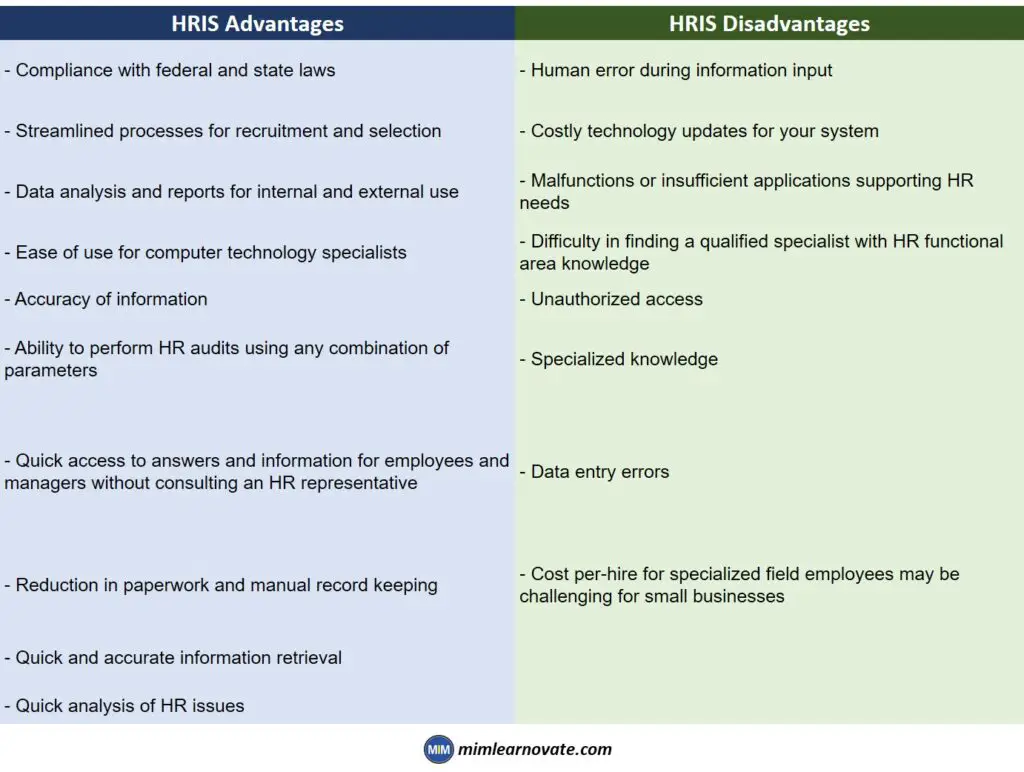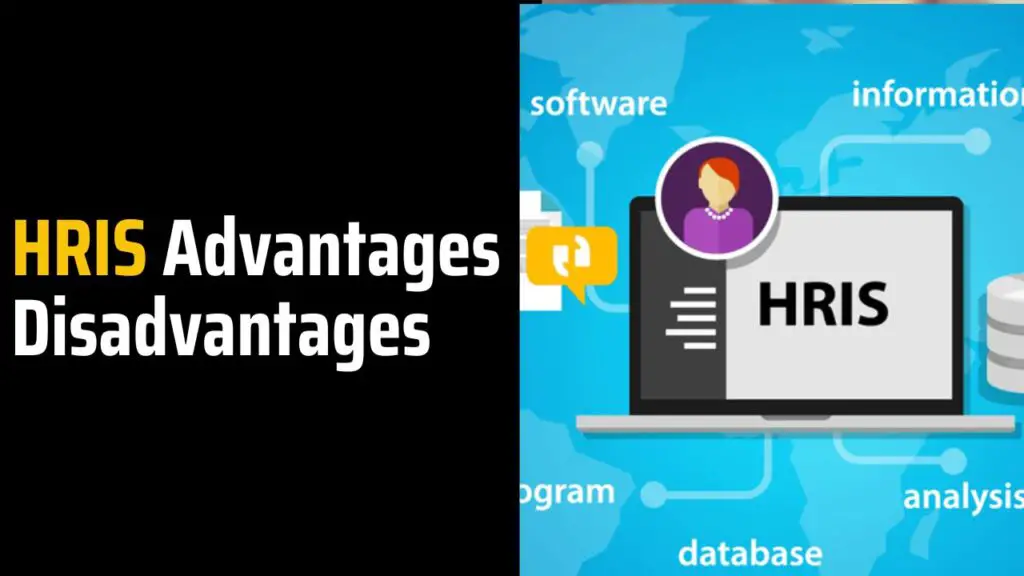Human Resources Information Systems (HRIS) have evolved since the 1980s, progressing from basic computer applications to sophisticated repositories of human resources data and procedures.
HRIS is not only the term for the technology itself, but also encompasses the HR discipline for specialists and professionals engaged in HR technology.
An HRIS is utilized for various employment functions, including applicant tracking, performance management, attendance, compensation and benefits administration, workforce analysis, and scheduling.
A common application of HRIS is employee self-service, which allows employees to access information and perform tasks independently, reducing the burden on HR staff.
The employee self-service feature is suitable for small businesses as it can be adjusted to meet the needs of workplaces ranging from a few employees to large companies with up to 10,000 employees.

HRIS
HRIS, or Human Resource Information System, is software utilized by HR departments for various tasks. Similar to CRM systems that manage customer data, HRIS focuses on candidate and employee information. It automates processes such as applicant tracking, hiring, onboarding, payroll, benefits, time tracking, succession planning, and retention. Features and customization options may vary depending on the developer. Larger companies often tailor HRIS to meet their specific needs by creating customized task lists.
HRIS systems typically contain employee name, contact details, and additional data such as department, job title, salary, training, and qualifications. Reporting capabilities are common, and some systems also manage applicant information and interface with payroll or financial systems.
An HRIS is a management tool designed to provide information for HR decision-making. Its importance has grown, especially in large or diverse companies, where decision-making is decentralized.
Large companies often benefit more from HRIS due to the similar development costs regardless of company size, making it a better investment for larger organizations. These systems are often customized to fit specific needs.
In simple terms, HRIS, HRMS, EHRMS, or HR technology, merges HR management with information technology. It streamlines HR activities and processes, integrating them into enterprise resource planning (ERP) software, allowing for centralized data management.
HRIS Advantages and HRIS Disadvantages
| HRIS Advantages | HRIS Disadvantages |
|---|---|
| – Compliance with federal and state laws | – Human error during information input |
| – Streamlined processes for recruitment and selection | – Costly technology updates for your system |
| – Data analysis and reports for internal and external use | – Malfunctions or insufficient applications supporting HR needs |
| – Ease of use for computer technology specialists | – Difficulty in finding a qualified specialist with HR functional area knowledge |
| – Accuracy of information | – Unauthorized access |
| – Ability to perform HR audits using any combination of parameters | – Specialized knowledge |
| – Quick access to answers and information for employees and managers without consulting an HR representative | – Data entry errors |
| – Reduction in paperwork and manual record keeping | – Cost per-hire for specialized field employees may be challenging for small businesses |
| – Quick and accurate information retrieval | |
| – Quick analysis of HR issues |
Advantages of HRIS
Understanding the advantages of HR software raises the question of why it’s not universally adopted. Many companies, particularly small businesses, may question the necessity of investing in performance management solutions. Whether you’re a prospective recruiter, HR auditor, or aspiring entrepreneur, it’s crucial to grasp the benefits of automating human resource management.
Recruitment Management
This feature includes applicant tracking, management, and reporting functionalities, aiding in efficient recruitment processes.
Reduced Paperwork
Firstly, HR managers are relieved from the burden of filling out numerous paper forms daily. Instead, they can digitize resumes, handbooks, applications, and other documents. Tasks such as processing advance payments or vacation requests are simplified to a few clicks, saving hours of paperwork.
This also streamlines benefits management, providing oversight of employees’ performance and achievements. HRIS software offers dashboards for easy monitoring of daily, monthly, and weekly progress, eliminating the need for extensive analytics.
Automated Reminders
The system can schedule events such as performance appraisals and benefit deadlines, automatically sending notifications and reminders if necessary actions are not completed.
Enhanced Organization
HRIS software consolidates important data into one central location accessible to all HR personnel. Roles and access rights can be configured once, saving time when onboarding new employees. Automating key HR processes simplifies workflows for colleagues, providing guidance on tasks, meetings, and scheduling interviews.
Improved Efficiency
When your recruiters are relieved from the burden of paperwork and file management, they can devote more time to their core responsibilities: recruiting new talent and ensuring employee satisfaction.
To enhance overall performance with an effective human resource management system:
- Establish metrics to track progress, such as the number of interviews conducted or retention rates. Customize HR tasks within specific departments and tailor your HRMS to meet your organization’s unique needs.
- When seeking new talent, utilize existing candidate contacts. Often, HR professionals fail to follow up promptly on opportunities due to a lack of suitable HR systems with organized information.
- Make use of HRIS functionality to enhance your current work. This could involve sending holiday greetings, organizing events, conducting online meetings, or administering satisfaction surveys. A comprehensive database containing relevant information enables a better understanding of employee preferences and feedback.
Enhanced Accuracy
With proper data entry and manipulation, HRIS typically leads to improved accuracy in information management.
Streamlined Data Management
HRIS enables you to input employee information once, simplifying various HR tasks. Similarly, updates need only be made in one location when employee details change.
Data Integration
Different components within the system can communicate with each other, facilitating comprehensive reporting, analysis, and internal evaluations. This integration also aids in preparing data for external audits.
Self-Service Functionality
HRIS allows employees to modify their own data, such as addresses, while managers can enter or retrieve data like performance reviews independently, reducing the burden on HR.
Document Hosting
HRIS can store company-related documents such as employee handbooks and safety guidelines, making them easily accessible and updatable in a centralized location.
Benefits Administration
HRIS supports benefits enrollment, notices, changes, and reporting, streamlining the administration process.
Disadvantages of HRIS
Data Security
Storing all employee information in one place raises concerns about security. Just like students seeking programming homework help prioritize cybersecurity, businesses must ensure data protection to prevent breaches. Invest in a reliable provider and secure IT infrastructure, especially with remote work becoming prevalent during COVID-19.
Securing sensitive data is crucial, demanding strong systems to prevent unauthorized access or accidental leaks. This involves setting up multiple layers of access control and continuous monitoring.
Cost
The financial aspect is another concern, particularly for smaller companies. Implementing and maintaining HRIS involves acquisition and ongoing maintenance costs. Cloud-based SaaS systems may offer some relief as they typically require lower initial investments.
Statistics are being overestimated
While automating the recruitment process simplifies tasks, managers must still prioritize a personal approach with candidates and employees. Certain metrics, like proactivity and positivity, can only be observed through direct communication, highlighting the limitations of relying solely on data.
Staffing
Larger installations may require hiring dedicated IT specialists to manage the system, adding to the overall operational costs.
Investment costs
Implementing modern software solutions can be expensive, requiring both financial resources and time for employee training. However, it’s essential to recognize that the long-term benefits outweigh these initial costs.
Other articles
Please read through some of our other articles with examples and explanations if you’d like to learn more.
Management
- Human Resource Management
- Management Information System
- Why is Information Governance Important?
- Transaction Processing System
- How Data Analysis Is Changing Information Governance?
- The St. Gallen Management Model
- System-Oriented Management
- Tools Transforming Knowledge Management
- Levels of Management
- Information Management Software
- Tools for Information Management
- Information Governance vs Records Management
- Management Information System Books
- Greenwashing: A Case Study on DWS
- Greenwashing Examples
Statistics
- PLS-SEM model
- Principal Components Analysis
- Multivariate Analysis
- Friedman Test
- Chi-Square Test (Χ²)
- T-test
- SPSS
- Effect Size
- Critical Values in Statistics
- Statistical Analysis
- Calculate the Sample Size for Randomized Controlled Trials
- Covariate in Statistics
- Avoid Common Mistakes in Statistics
- Standard Deviation
- Derivatives & Formulas
- Build a PLS-SEM model using AMOS
- Principal Components Analysis using SPSS
- Statistical Tools
- Type I vs Type II error
- Descriptive and Inferential Statistics
- Microsoft Excel and SPSS
- One-tailed and Two-tailed Test
- Parametric and Non-Parametric Test
Marketing
- Strategic marketing planning
- Marketing Environment
- Consumer buying decision process
- Factors Influencing Consumer Behavior
- Product Positioning
- Target Market Strategies
- Market Segmentation
- STP Process
- Data Analysis Process
- Consumer Adoption Process
- Branding
- Product Life Cycle
- Product Attributes
- Price Discrimination
- Service-Based
- Company Vs. Product-Based Company
- Product Classification
- Penetration Pricing and Price Skimming
- Case Study of Nestle
- Fast-Moving Consumer Goods
- Motorola’s Customer-Defined, ‘Six-Sigma Quality
- PEST And a SWOT Analysis
- Web Design Company Vs. a Web Designer
- Internal and External SWOT Analysis
- Strategic Opportunism
Marketing Analysis
ChatGPT
- Paraphrase Text
- PowerPoint Slides
- Learn Languages
- Write Code in Python
- Write Literature Review
- Document Review
- Job Interview Preparation
- Prompts For Students
- Write Cover Letter
- Write Resume
- Write Code
- Job Applications
- Write SQL Queries
- Write Excel Formulas
- Academic Writing
- Translate Text
- Keyword Research
- Business Idea Generation
- Business Entrepreneur
- Use ChatGPT on WhatsApp
- Virtual Research Assistant
- Meta-Analysis in Research
- Large Documents
- Hypothesis Development
- Share ChatGPT Responses
- Text Analysis
- Upload PDF on ChatGPT
- Books ChatGPT



